To grow a small business, you have to wear many hats—that of a founder, marketer, accountant, salesperson, customer service, and even your own coffee runner.
And guess what’s an area that helps you cure your headaches related to all these business functions?
Social media.
Well, maybe it won’t help you that much with getting coffee. But social media certainly frees up a huge chunk of your time to let you kick back, relax, and brew a frothy cup of joe.
In today’s largely digital marketplace, social media is the trusted sidekick that you need to market your product or services, engage with customers, and grow your business.
Besides, social media is quickly transcending into a business function of its own, like HR or finance. It’s already become a business imperative when you consider the changing landscape of customers’ expectations today.
Studies have found that 54% of people use social media to research products and services before they buy them.1
Today’s customers also expect brands to be present and offer their services in places where they hang out the most, i.e., social media.2
But how should you use social media for a small business? There are just too many channels out there. And how exactly do you leverage each one?
In the next few sections, we will cover:
Let’s start by touring the most famous social media platforms first.
The 6 most common social media platforms for business
Over the past two decades, social media has grown so big in influence that now we have a strange problem at hand: the problem of overabundance.
If you start using all social media platforms to grow your business, it will drain your energy, and pretty quickly you won’t have enough time and dedication left to use the ones that actually matter for your business.
One way to easily bypass that overwhelm is to identify who your audience is and which social media platforms do they spend their time on.
Once you identify that, you can save a lot of time experimenting with the likes of TikToks and Instagram and only work on making the most of top social networks for business that offer you the best return on investment (ROI).
A second way to make this job easier is by using a tool like RingCentral Engage Digital™ to help you manage all your social media profiles from a single place:
RingCentral Engage Digital uses smart automation to consolidate your social media profiles in one place. This helps you offer a more consistent customer experience across all social platforms—especially because anyone on your team can pick up on a conversation—and reduce the pressure on your support team’s bandwidth.
🕹️ Get a hands-on look at how RingCentral can help your business manage all your social profiles more easily by booking a product tour:
💰 You can also use this calculator to see roughly how much your business could save by using RingCentral to support your team’s communication with each other—and clients.
That said, let’s look at the six best social media platforms for small businesses that you should use to grow your business.
1. Facebook
Facebook has the biggest clout among all other social media platforms because of the size of its audience, its ease of use, and its low-cost high-returns value proposition.
Over 2.45 billion people use Facebook daily to connect with their friends and families, stay abreast of world affairs, and buy and sell goods or services.
Think of how your business can benefit if you can attract even a fraction of the massive audience who use Facebook every day.
Facebook is a good fit for businesses of all shapes and sizes. It’s especially great for mom-and-pop shops, e-commerce websites, and startups—small businesses who don’t necessarily have a spare change lying around to market themselves.
That’s because Facebook gives you total control over how much you want to spend on the platform.
With just a little to no budget, you can use Facebook in several ways to drive traffic to your website, run ultra-targeted ads, grow a close-knit community, and improve your customer support.
Here’s one of our favorite examples from a brand that spent just $20/day on Facebook ads to reap much bigger rewards.
Erika Volk is a fitness coach who runs the PCOS Personal Trainer website—a business she started to help women like her recover from polycystic ovary syndrome (PCOS).
All serious about growing her business but not sure about Facebook, her team decided to run a campaign for $20 a day on Facebook.
They advertised an email course to their target market on Facebook, earned more than 1,800 email subscribers through the campaign, and drove 11,850 monthly visitors to their website at 6 cents per visitor.
Here’s a sample of the ad creative that Erika Volk ran on Facebook:

2. Twitter
What should you do if you know your target audience is younger, more tech-savvy, and an educated bunch? You should perhaps ask a little blue bird to help you reach them.3
That’s right—if Facebook ain’t your thing, Twitter probably is. The 280 characters of tweets on Twitter offers unlimited potential to turn your brand into a household name among your target market.
For example, a recent research has found that 93% of people who follow small and medium-sized businesses on Twitter are more likely to buy from them in the future.4
And while Facebook’s forte lies in ads and marketing, Twitter is great at offering quick customer service. Consider 85% of small businesses who say that Twitter is already a crucial part of their customer service strategy.5
But that doesn’t mean you can’t use Twitter as part of your customer acquisition strategy at all. It actually competes head-to-head with Google and Facebook ads in giving you full control over your ad spend on the platform.
Twitter is aware of the popularity it enjoys among the small business community, which is why it has a dedicated small business resource page to help new entrepreneurs discover all the tools they need to succeed in the platform.6
Brands like Casper (mattress makers) use Twitter to engage with their customers and respond to customer service queries round the clock.
Their Twitter page links to the online customer support page and also displays their toll-free support number—which means they treat their Twitter presence mostly as a customer service channel:
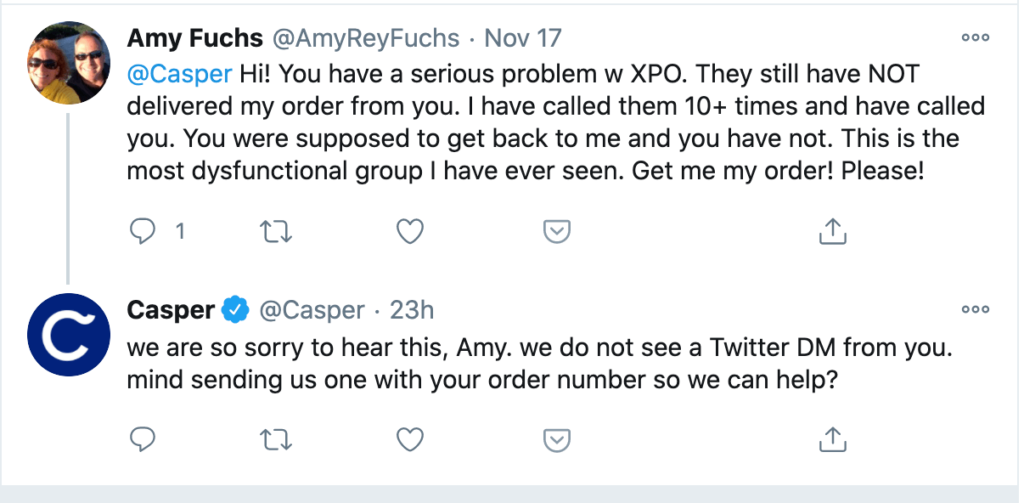
3. Instagram
If Instagram were a person, she would probably be selling products as a social media influencer on… well, Instagram!
Instagram is rising as the hottest social media platform with over 1 billion monthly users.7
Research shows that about 11% of American social media users shop on Instagram8 and US brands spend close to 69% of their influencer budget just on Instagram.9
For most small businesses, using Instagram means reaching out to thousands of potential customers online just through their smartphones.
You just need a solid social media strategy, a fair knowledge about Instagram’s general workings, and a consistent schedule to create engaging new posts or regram third-party posts.
Social media users generally love visual content on their feed and visuals are especially critical for expanding your brand’s reach on Instagram.
This is the reason why Instagram is most popular among small craft shops, food joints, online apparel stores, and cosmetic retailers.
All these brands cater to the same kind of audience—young, urban professionals—who also share the love of aesthetically appealing photos and videos.
Pura Vida Bracelets is one of such smaller brands that has tasted success on Instagram because of their visual-heavy Instagram strategy.
For example, the brand showcases its product being worn by their models in the lap of nature, close to the sunny beaches of Costa Rica, and as an expression of living the Pura Vida—the pure life.
Take a look:
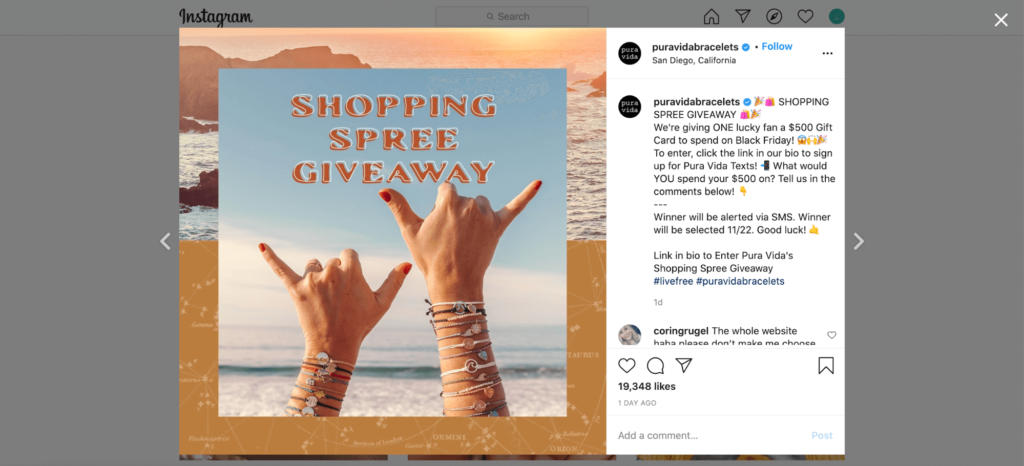
The brand banks so heavily on Instagram that their website mimics Instagram’s interface for a consistent user experience:
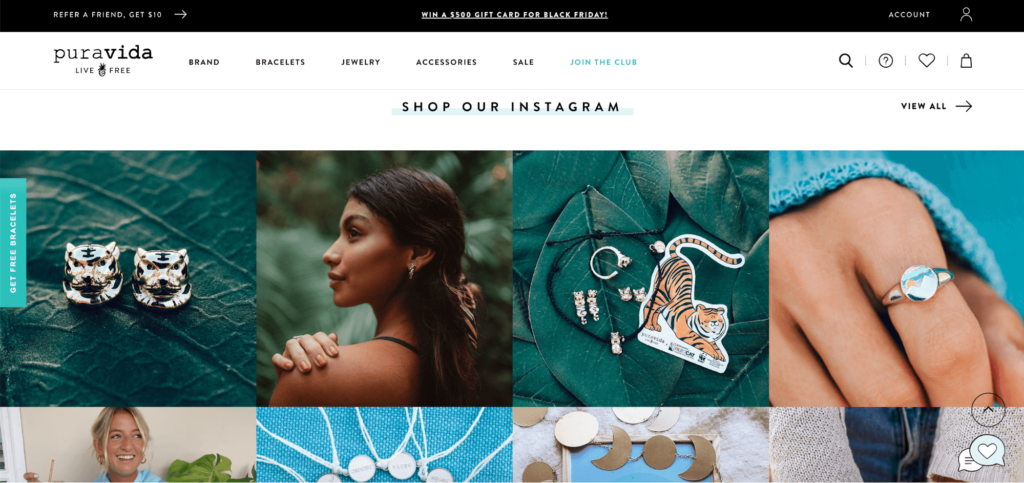
4. Pinterest
Pinterest is yet another social media platform where visuals talk louder than words.
But unlike Instagram, Pinterest’s scope goes beyond serving snazzy retail brands since the platform also caters to business-to-business brands in spreading their influence.
Pinterest is a social media platform that helps people discover and share images on topics that they are interested in. You can think of it as the social media network for hobbyists or niche consumers.
💡 Pro-tip:
If your brand sells anything that is of interest to mothers, you can’t afford to not include Pinterest in your social media strategy. That’s because almost two-thirds of Pinterest users are women.10 In the US, that number represents eight out of every 10 moms.
Pinterest recently overtook Snapchat to become the third-largest social network in the US—right after Facebook and Instagram.11
Platforms like Pinterest and Instagram are growing steadily in popularity across the world because image search is on the rise since more than 62% of millennials and Gen Zers prefer to get visual results for their queries.12
One of the best things about Pinterest is the ability it gives users to curate their favorite content in a visual format. This happens in the form of Pins, Boards, Saved Pins, and Pinterest Lens.
Just like in other social media platforms, you can create a business profile on Pinterest to create your online presence, distribute your content, market your product and services, and engage with your customers.
Petplan, a pet insurance company, uses Pinterest extensively to push relevant content and offer customer service.
They categorize their Boards by dog breeds and share specific and relevant information for pet owners on how to take care of their dogs belonging to a respective breed.
To make the most of Pinterest’s traffic, they even include “pin it” buttons directly on their website and email footers.
Their strategy has paid off well—Pinterest is Petplan’s second-highest source of referral traffic (after Twitter) and has earned them 69% more page views plus a 12.5% increase in insurance quotes.
Here’s a look at their brand page on Pinterest:
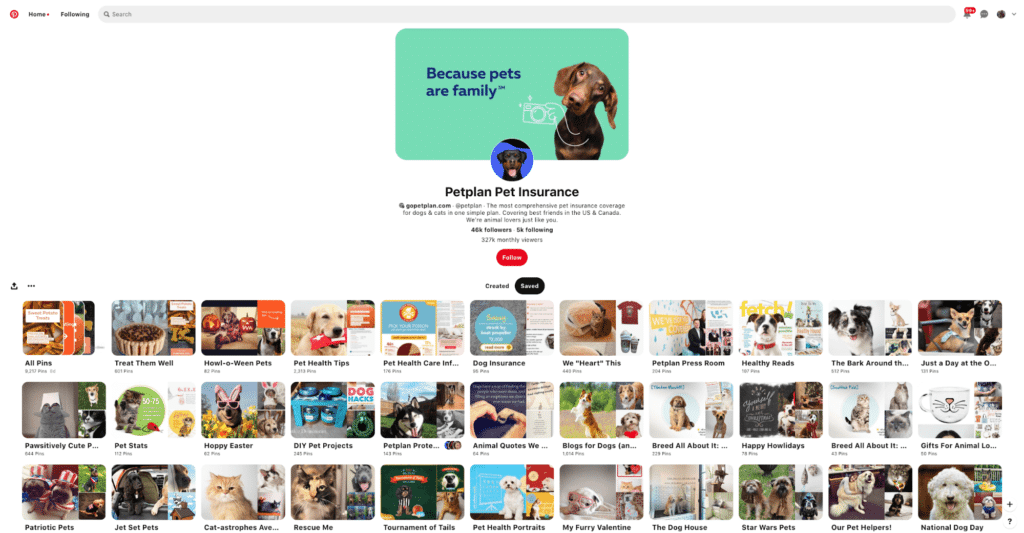
5. Quora
A lot of small businesses waste their time online by trying to build their inbound marketing engine—an organic presence—that they think will bring them windfall good luck once the wheels start turning.
That’s definitely true, but there’s a smarter way to grow your brand without waiting for your SEO (search engine optimization) to start working—which sometimes takes months.
Quora, a Q&A-based social media channel, helps you speed up your organic marketing efforts and grow your business’s footprint at scale.
Quora is a great place to build your personal or business brand, build relationships with relevant audiences, and take advantage of Quora’s massive email lists.
Just like any other social media platform, reaping your rewards from Quora is a two-way street. You have to keep giving value to your audience—mostly by answering questions in your specific domain—before you start seeing the tides turning in your favor.
When you answer questions, Quora sends the most viewed and voted answers to millions of its email subscribers—which is crazy!
Most of the Quora answers are also SEO optimized by default, increasing your likelihood to rank on top of Google search results for relevant keywords.
When time is of the essence, you can also take advantage of Quora for Business features—like Quora Ads—to get faster results. It works pretty much like how Facebook for Business works.
For example, Quora also offers a way for brands to install a snippet of code on their websites—known as pixels—so that you can track your website visitors’ behavior and remarket your products to them on Quora.
You can also target audiences on Quora based on certain keywords or their topics of interest—much like on Facebook.
Wishpond—an online marketing platform—turned Quora into their second-highest traffic generation source by attracting over 23,000 views to their posts on Quora in just under a month.
This number trickled down as 13,470 visitors to their business website and hundreds of leads.
Here’s an example of Wishpond using Quora to subtly plug their brand into a relevant Q&A thread:
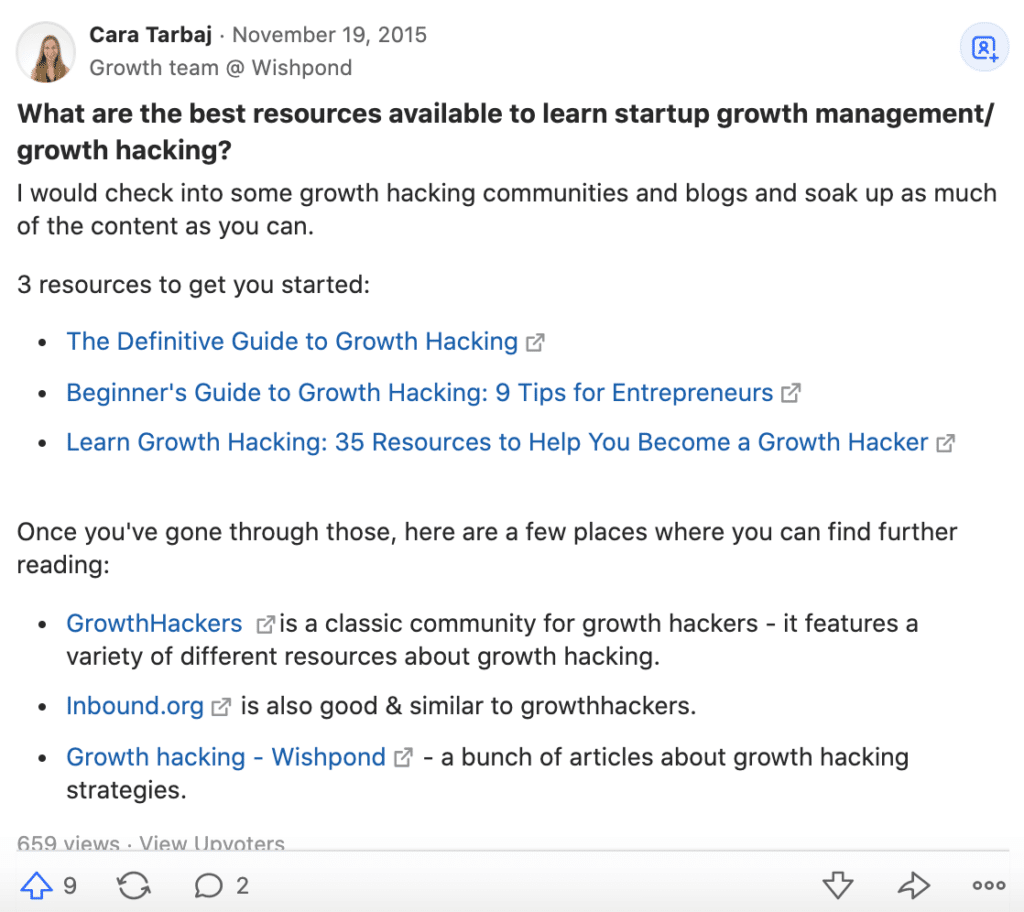
💡 Pro-tip:
In Quora, it’s tempting to answer all the general questions related to your industry. Don’t fall for that trap. Stick to answering only the questions that are highly relevant to your niche.
6. LinkedIn
Officially dubbed the social media platform for business professionals, LinkedIn has come a long way in recent years.
It’s no more just a social media platform, but a great place for you to network with others in your industry, hire the right talents, and generate qualified leads.
Unlike all the other platforms we have discussed so far in this article, LinkedIn is perhaps the best social channel for B2B (business-to-business) companies.13
When it comes to targeting, LinkedIn gives Facebook a run for the money. For example, here are all the ways you can target your audience on LinkedIn:
- Gender
- Academic degree
- Job title
- Location
- Seniority level
- Years of experience
- Skills
- Groups
- Job functions/department
- Company name/size/industry
And since it offers a laser-focused targeting, LinkedIn ads cost a pretty penny. Running ads on LinkedIn is not as affordable as Facebook, Instagram, or Twitter because it’s a high-value platform for B2B companies—who usually have bigger pockets than B2C companies.
But that doesn’t mean it’s not a good fit for small businesses. LinkedIn offers plenty of organic marketing opportunities for you to market your business at scale, build brand awareness, and attract the right talents to your business.
Austin-based Finkelman Immigration Law Firm has used LinkedIn’s organic reach to increase its brand presence and turn casual LinkedIn members into its clients.
Jason Finkelman, the firm’s Managing Member and Immigration Attorney, used LinkedIn to regularly post thought leadership content, videos, and articles around US immigration topics relevant to his target audience.
Despite his busy schedule as a one-man team, Finkelman has attracted scores of LinkedIn members to follow him on LinkedIn and converted dozens of LinkedIn connections into clients.
Here’s a snippet of one of his articles published on LinkedIn:
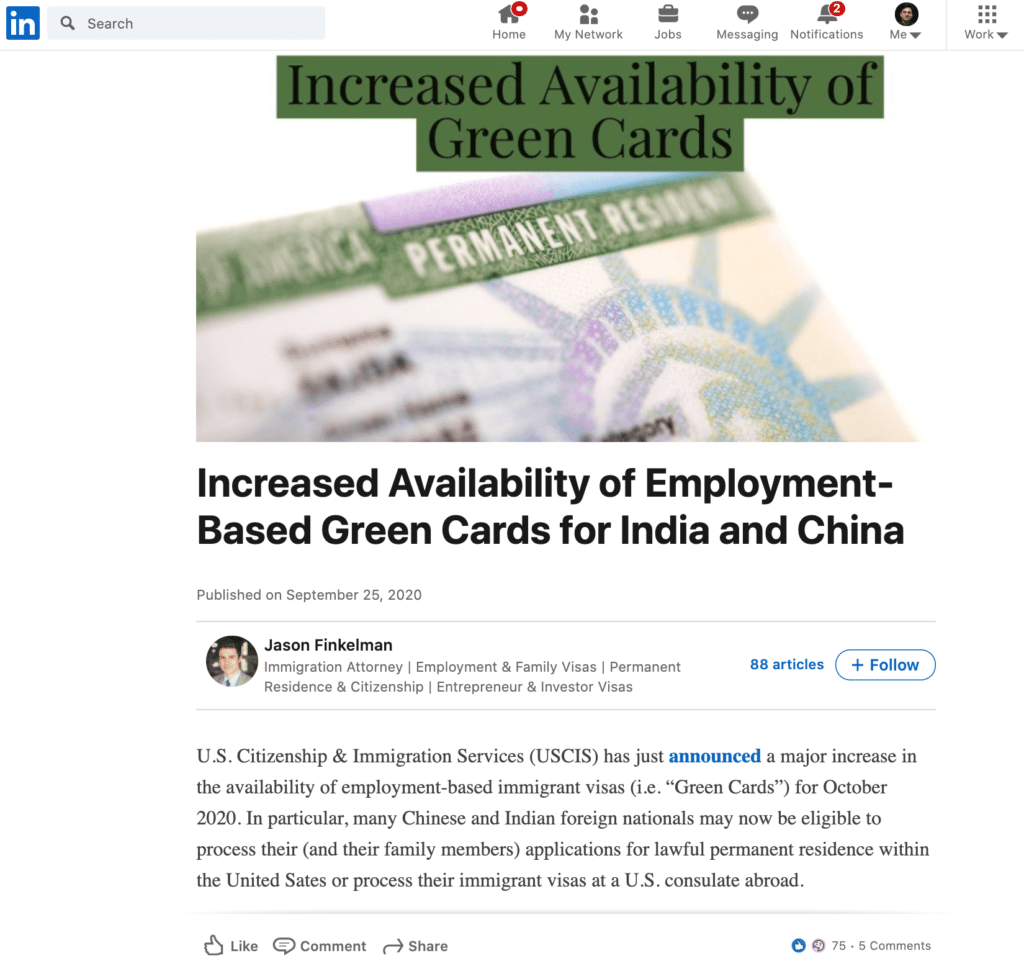
8 tips for how to use social media for business
Now that you might have decided which social channel is great to meet your target audience’s expectations, here’s a step-by-step guide on how to use a social media platform.
1. Build brand awareness
If you’re starting a new business from the ground up, social media can help you build top-of-mind brand recall—an important precursor to earning your consumers’ trust.
The disruption in social media has changed the marketing landscape today into a level playing field for businesses of all sizes.
You can take on the biggest competition in your domain and topple their monopoly—just by curating engaging content and sharing value with your prospects.
Use social media to create thought leadership posts and focus on building your brand as an authority in your niche.
If you play your cards right, prospects will soon flock to your brand because they will start perceiving you as a reliable company to do business with.
2. Distribute your content
Social media is like a busy marketplace teeming with activity. You just have to go in, introduce your brand, and go about doing your business.
If your brand is keen on creating a ton of content like blogs, videos, or newsletters—use social media to promote your best content pieces and drive traffic to your website.
Similarly, use Facebook or LinkedIn to run interactive marketing campaigns, launch contests, or drive sign-ups to your website page.
In addition to helping you with better SEO ranking, using social media to distribute your content will help you generate leads and fatten your sales pipeline.
3. Make the most of your ad budget
Marketing is not worth your time if it doesn’t give you the due dividends.
With social media, you don’t have to worry about losing your marketing dollars on ad spends with unclear returns on investment. (Which is historically what brands used to do with TV, newspaper, and billboard advertisements.)
Use social media’s data and analytics to take absolute control of how much you want to spend on ads. Get a blow-by-blow account on where each dollar was spent, calculate the outcome of each activity, and tweak the campaign for future success.
4. Offer more responsive customer service
Treat social media as a drive-thru window for your customer service to quickly solve your customers’ problems before they snowball into complex support tickets.
Toll-free phone numbers and live chat on websites aren’t enough to satisfy your customer demands these days. Instead, you have to come up with an omni-digital customer engagement strategy with social media at the heart of it.
Use RingCentral Engage Digital to merge your social identities and provide a consistent experience across all channels. This way, even if someone messaged you on three different social media platforms and sent you emails, you’d still be able to see that whole progression of their relationship with your business in one convenient thread:
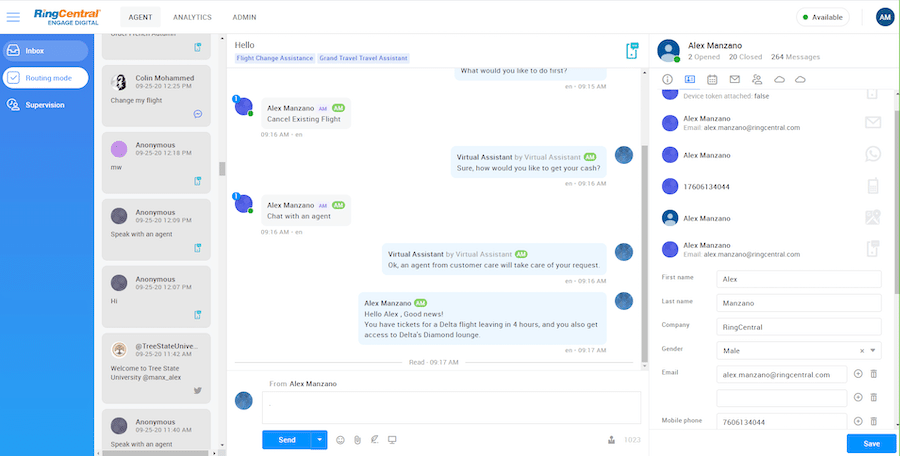
If you find yourself answering questions on a whole variety of different channels, then you might want to look at a contact center solution like RingCentral Engage to help you provide better customer support, route and prioritize messages based on urgency, and effectively manage staffing during peak seasons.
5. Grow your personal brand
Don’t get fooled by the word “personal” in personal branding because it’s anything but personal.14
Oftentimes, personal branding is an extension of your corporate branding or employer branding. One good way to build your personal brand is to educate your audience about the unique value you can offer them and convincing them to buy from your brand.
(In most cases, building your personal brand eventually brings value to your business, so it’s worth doing even if some people think it’s a “fluffy” endeavor.)
Want to get started right now? Use social media to establish yourself as an authority figure in your space. Lend your support to people who need your expertise.
Once you become a leading voice in your niche, you’ll have a higher chance of attracting the right kind of customers, partners, and investors to help you grow your business.
6. Stay ahead of the competition
Use social media to understand your competitive landscape better. Engage directly and frequently with your prospects to know their pain points.
Run polls on Twitter, ask your existing customers to review your brand on Facebook, or analyze your customer segmentation better using LinkedIn ads. The nice thing about social media is that it’s all public—which means you can keep tabs on what your competitors are doing and promoting every day.
Beyond watching your competition from close proximity to identify the gaps in their offerings, you can also use social media to monitor your own brand’s reputation by keeping a tab on your @mentions and just searching for your brand’s name in conversations to see if anything comes up.
Channel the time you spend on social media like a bridge to connect with customers and solve their problems.
The more frequently you interact with them, the better your brand’s engagement and the stronger your relationship with customers.
7. Hire the best talent
A business is only as good as its employees. Traditional channels for hiring talents like job boards or newspaper ads are still popular, but smart businesses are using their social networks to look for talent that’s flyiing under the radar.
Social media is a great way to build your brand as an employer (do you have fun team events? Share pictures on your social media channels!) and attract world-class talent to work for your brand—while boosting the perception of your brand overall.
The biggest way to hire directly via social media right now is probably to create job posts on LinkedIn to reach candidates you can’t find within your postal code.
💡 Pro-tip:
Promote employee branding to exercise employee advocacy or showcase the human side of your brand through social media. Use platforms such as Workplace by Facebook to engage your employees, retain them, and help them collaborate better among themselves.
8. Build a community around your brand
To increase brand loyalty and maximize customer lifetime value, use social media to create groups and communities.
Facebook and LinkedIn both share the common feature to allow brands to create “Groups” in their respective platforms.
The benefits of such communities are immense. For instance, such groups tend to spread your brand’s popularity outside of your immediate circle of influence.
They also act like magnets to attract more like-minded people to join the community—which in turn helps you further your brand’s impact.
Most importantly, online communities naturally evolve to become an informal support group of members who help each other out when it comes to resolving certain issues.
It’s a great way to offset the traffic away from your customer support while giving your community members a noble cause to bond with each other.
Cash out the benefits that social media for small business offers
Most brands treat social media as a side project—a place for them to merely maintain their presence online.
If you haven’t acknowledged the power of social media for small business, now is the time to harness its potential to take your business to the next level.
Know that just by investing a couple of hours every day on the social media of your customers’ choice—you can outrank your competition, drive more traffic to your website, and convert more leads into customers.
Go ahead, give your social media strategy a fresh start. Try out the tips mentioned in this blog and breathe life into your brand’s social media presence.
1 blog.globalwebindex.com/chart-of-the-day/social-browsers-brand/
2 review42.com/how-much-time-do-people-spend-on-social-media/
3 pewresearch.org/internet/2019/04/24/sizing-up-twitter-users/
4 ventureharbour.com/twitter-business-statistics-trends-on-twitter-advertising/
5 b2bwave.com/p/leverage-the-power-of-twitter-for-your-b2b-business
6 business.twitter.com/en/resources/small-business.html
7 adespresso.com/blog/instagram-statistics/
8 blog.hootsuite.com/instagram-statistics/
9 bigcommerce.com/blog/influencer-marketing-statistics/
10 edition.cnn.com/2019/03/22/tech/pinterest-ipo/index.html
11 blog.hootsuite.com/pinterest-statistics-for-business/
12 businesswire.com/news/home/20180829005092/en/New-Research-from-ViSenze-Finds-62-Percent-of-Generation-Z-and-Millennial-Consumers-Want-Visual-Search-Capabilities-More-Than-Any-Other-New-Technology
13 yaagneshwaran.com/blog/linkedin-for-growth/
14 forbes.com/sites/williamarruda/2017/11/05/nine-misconceptions-about-personal-branding/
Looking For Startup Consultants ?
Call Pursho @ 0731-6725516
Telegram Group One Must Follow :
For Startups: https://t.me/daily_business_reads




